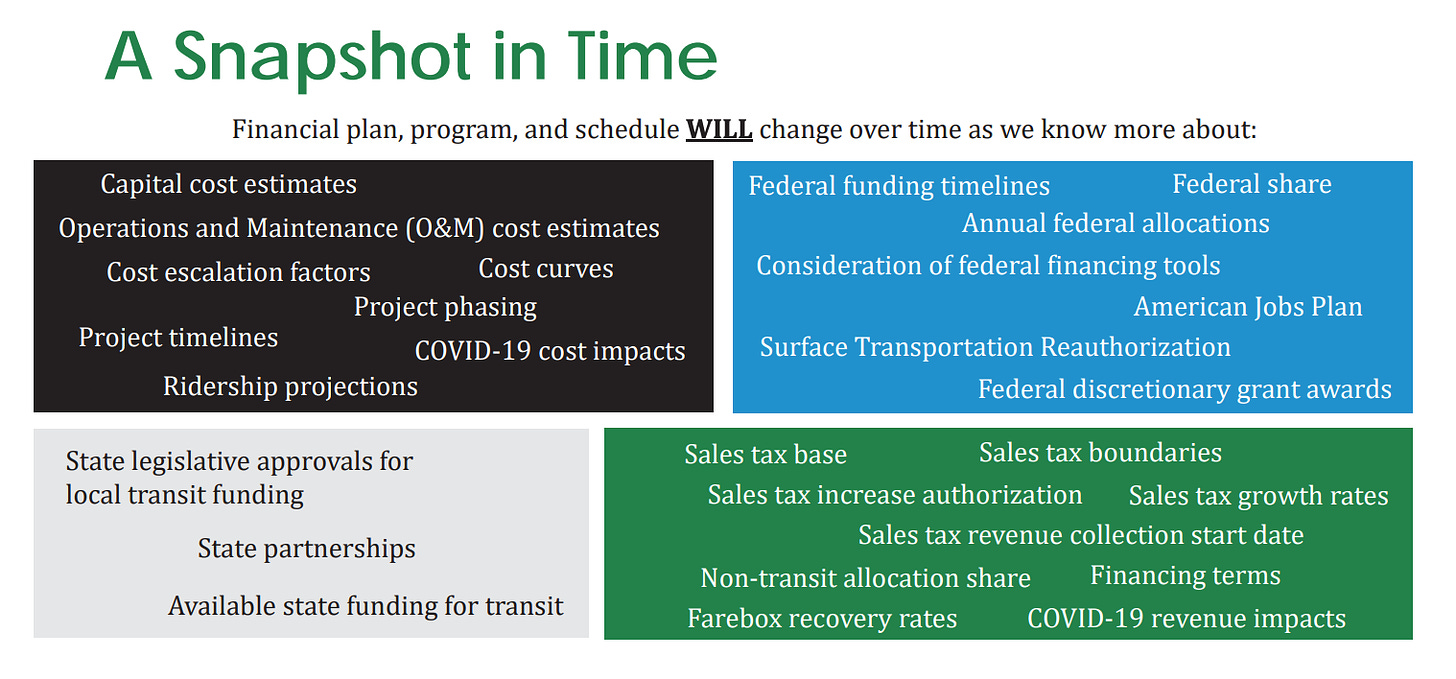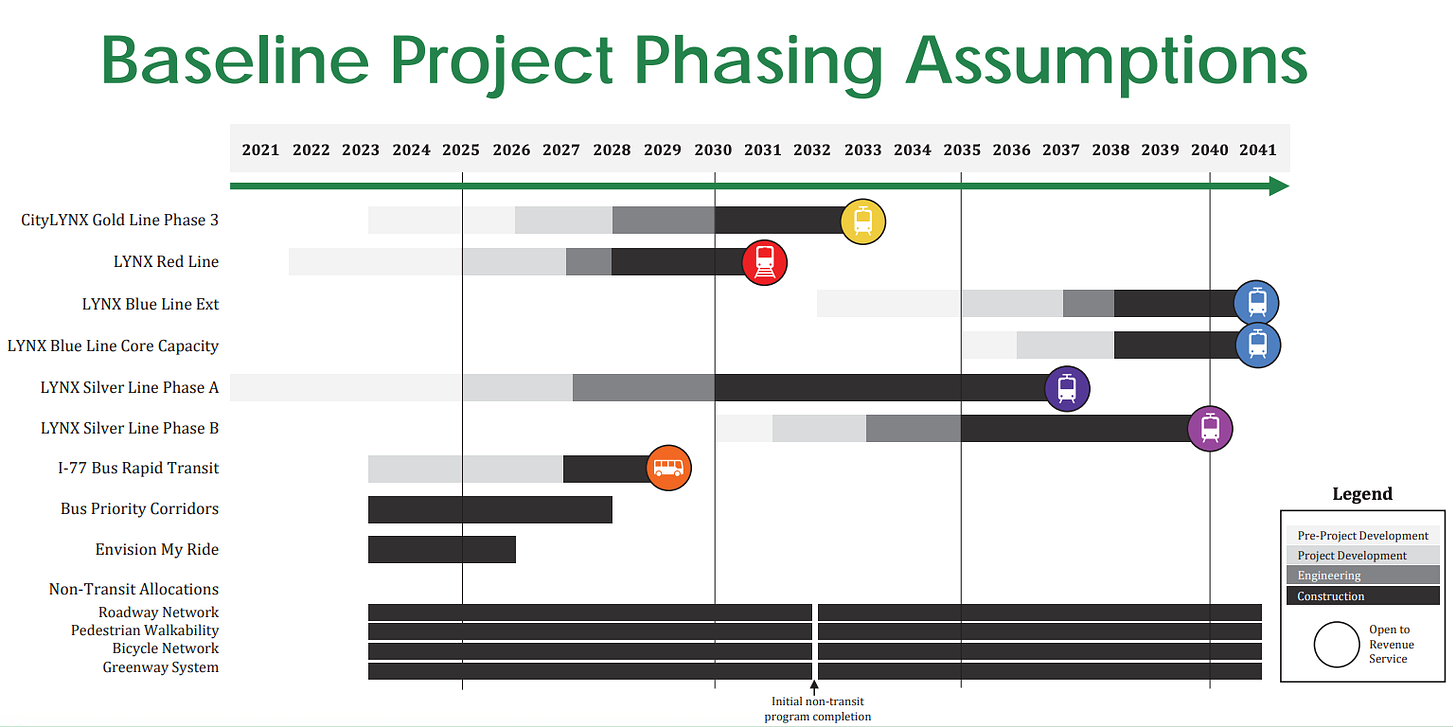You’re reading Transit Time, a weekly newsletter for Charlotte people who leave the house. Cars, buses, light rail, bikes, scooters … if you use it to get around the city, we write about it. Transit Time is produced in partnership among The Charlotte Ledger, WFAE and the UNC Charlotte Urban Institute. Audio versions 🎧 of newsletters in the Charlotte Ledger family, including Transit Time, are available on Spotify.
Analysis: With numbers refined, Charlotte’s transit plan still needs plenty of outside help to make it happen
by Tony Mecia
The headlines emerging from Monday’s City Council meeting about the transit plan were stark: “Cost increased and timeline pushed back for light rail expansion”; “The price tag just increased for Charlotte’s big transportation plan”; “Charlotte confirms hefty price tag for Transformational Mobility Network.”
That’s all true — city officials, sharpening their pencils on the actual details to build multiple rail lines and sidewalks and greenways, sketched out specifics like never before. And they found it will take more money ($13.5 billion) and more time (until 2041) than envisioned just six months ago.
When you start talking about dates and figures, they have a way of taking on lives of their own. They sound inevitable and certain. But in watching Monday’s meeting, it’s clear that almost nothing about this plan is certain. The numbers are very rough estimates. They’re based on so many variables that they’re almost certainly wrong and could be far off the mark.
Even if all of Charlotte were energetically pro-transit and in favor of spending billions to expand light rail — and it’s not, with polls suggesting it’s closer to evenly split — it still might not happen in its current form. That’s because Charlotte will need a lot of outside help — from slow-moving federal government agencies with tight budgets, tax-averse state legislative leaders, skeptical northern Mecklenburg towns, a stubborn railroad and, of course, voters.
It’s not an impossible task. But it seems like a hard one. And it will require some flexibility from city leaders, who acknowledge that we’re in the early stages of an idea that, if the stars align just right, will take at least 20 years to complete.
“Our strong desire,” city manager Marcus Jones told council members, “is that you tell us to just keep working on it.”
The unknowns: The city’s latest transit plan projections contain a lot of assumptions and rely on outside agencies and support. (Slide from presentation at Monday’s City Council meeting.)
Light rail, commuter rail, buses — with better price tags
The scope of the plan has changed little since a task force chaired by former Mayor Harvey Gantt made recommendations in December 2020. But there are now more up-to-date numbers attached to the projects:
Build the Lynx Silver Line (light rail) from Matthews to uptown to Belmont, $8.1 billion.
Build the Lynx Red Line (commuter rail) from uptown to northern Mecklenburg, $674 million.
Extend the Lynx Blue Line (light rail) through Pineville and Ballantyne, $1.5 billion.
Extend the Lynx Gold Line (streetcar) to the Eastland area and to Rosa Parks Place in west Charlotte, $652 million.
I-77 bus rapid transit, $229 million.
Bus priority corridors, $230 million.
Along with a few smaller projects, that brings capital costs for transit in the plan to $11.6 billion. And there’s another $1.9 billion for greenways, bike networks, sidewalks and so on, for a total cost of $13.5 billion.
City leaders refer to it as the “transformational mobility network” or the “Charlotte Moves” plan, since it is not only for transit. But 86% of the money would go to rail and buses.
The latest projections on when different parts of Charlotte’s transit plan will be complete. Bus rapid transit would be completed first, in 2029. Sorry, Ballantyne — your light rail extension won’t be ready until 2041. (Slide from presentation at Monday’s City Council meeting.)
Where does the money come from?
The thorniest question has always been how to pay for a massive expansion of transit in Mecklenburg. Leaders seem to have settled on a mix of revenue from raising the sales tax by 1 percentage point, to 8.25% from 7.25%, and from grants from the Federal Transit Administration (FTA) .
Neither of those is certain.
On the sales tax, that would require the Republican-controlled General Assembly to grant permission for Mecklenburg County to hold a referendum. And voters would have to approve it. The timeline presented Monday assumes Mecklenburg would start collecting the additional sales tax in 2023.
But the General Assembly might not be willing to grant permission because northern Mecklenburg towns — Davidson, Cornelius and Huntersville — are skeptical of the plan, since there seems to be no progress on building the Red Line. That’s because Norfolk Southern controls those tracks and seems unwilling to allow them to be used.
“That’s been difficult to get the buy-in, especially from the north,” Jones said Monday.
And he seemed to suggest the city might consider moving forward with a sales tax referendum that excluded the northern towns: “There are other scenarios that can factor in a sales tax that may be smaller … Is there an opportunity to have something that is, I guess, more restrictive and not necessarily the entire county?”
Of course, that approach would bring in less money. But if there’s no hope of building the Red Line because the tracks are unavailable, a diminished source of revenue might be OK — though it would require shrinking the plan’s vision.
Federal help: no guarantees
The other pot of money envisioned to help pay for the transit plan — the Federal Transit Administration — is no sure thing, either.
Carolyn Flowers, a city consultant who was formerly the head of CATS, told council members: “FTA is characterizing that there is a stress on funding levels with a high number of projects, and administration policies regarding the grant program by the prior administration have contributed to lower award levels.”
Transit advocates are hoping that a new infrastructure bill in Washington will provide more money. But even if it does, the process is likely to be competitive and would take years to fully fund all the components of Charlotte’s plan. Other transit systems vying for the money are likely to include those in San Antonio; Austin, Texas; Jacksonville, Fla.; and possibly Nashville and Las Vegas, Flowers said.
Robert Puentes, CEO of the Eno Center for Transportation, a research organization in Washington, told Transit Time that there are still plenty of uncertainties over the infrastructure bill.
“All signs point to there being a lot of support for transit in there, but we’ll have to wait for a lot of those details before folks start cashing checks,” he said.
Monday’s presentation did not mention the possibility of state funding, which was a component of the task force’s recommendations in December.
Another question mark: Who will control the plan, and the money? In response to a question from council member Ed Driggs, Jones acknowledged that the city is looking into asking the state legislature to create a separate governing body — like some kind of regional transit authority. Since the light rail has the potential to spill into neighboring counties, the city wants to ensure that its credit isn’t backing a project for other jurisdictions.
“When you start to have a project that is outside the city of Charlotte, you don’t want to carry that on our full faith and credit,” he said. “What we are contemplating is to have this have its own credit, so it’s not backed by the city’s credit.”
Mayor Vi Lyles put the question of sales tax revenue and spending in more Vegas terms: “What’s in Mecklenburg would stay in Mecklenburg.”
What we know, and what we don’t
Former secretary of defense Donald Rumsfeld, who passed away Wednesday at the age of 88, was once famously quoted talking about the Iraq War and distinguishing between “unknown unknowns” — things you don’t know that you don’t know — and “known unknowns” — things you know you don’t know.
Charlotte’s transit plan is making progress. It has a rough sketch and some numbers attached to it. There’s still plenty we don’t know — but at least we are starting to get a better sense of what those things are.
Tony Mecia is executive editor of The Charlotte Ledger. He has been a journalist in Charlotte since 1997.
Scheduling note: There will be no Transit Time newsletter next week. It will return Thursday, July 15.
In brief…
Resurfacing Mecklenburg roads, I-85: The N.C. Department of Transportation has awarded a $6.7 million contract to resurface and reconstruct shoulders of more than 20 miles of roads in Mecklenburg County, the department said this week. The list includes Providence Road between Sardis and Ferncliff roads; Independence Boulevard between Windsor Square Drive and Rice Road Extension in Matthews; Steele Creek Road between Hoover Creek Boulevard and the S.C. line; Old Statesville Road between N.C. 73 and Gilead Road in Huntersville; Brookshire Boulevard between Lawton Road and I-85. Work could start by the end of this month and is expected to wrap up by August 2022. A separate $15.3 million contract calls for repaving lanes on I-85 between Brookshire Boulevard (Exit 36) and North Tryon Street (Exit 42). That could start this month and would be complete by May 2023. (NCDOT)
Crowded airport predicted: Charlotte Douglas International Airport says it’s expecting big crowds nearing pre-pandemic levels this July Fourth weekend. Today, Friday and Monday are forecast to be the most popular travel days. The airport recommends arriving three hours before departure time. This is also the final weekend before higher parking prices kick in. Those take effect Tuesday. (Charlotte airport)
Silver Line safety: The City Council on Monday approved an $866,000 contract for safety and security certification services on the proposed Lynx Silver Line. The contract is with the firm AECOM.
Free beach, if you take a shuttle: People heading to Ramsey Creek Beach on Lake Norman this weekend can get in for free if they take a shuttle by the Charlotte Area Transit System and the Mecklenburg County Park and Recreation department. The beach is open 12-5 p.m. Saturday and Sunday. It’s the first time it has been open since September 2019. The free shuttle leaves from the CATS Park & Ride lot at 19752-19758 One Norman Drive in Cornelius. Cars cost $10 to get in for country residents.
All those good drivers in Charlotte: Charlotte ranked No. 20 on a list of cities with the best drivers. The ranking by insurance portal QuoteWizard is based on an examination of data on accidents, DUIs and traffic citations. Birmingham, Ala., was ranked as having the best drivers. Omaha, Neb., came in with the worst. (QuoteWizard)
In case you missed it
Recent editions of the Transit Time newsletter:
“Back to work conundrum: Where to park?” (June 24)
“Charlotte’s scooters are making a comeback” (June 17)
“Local transit ridership is slow to recover” (June 10)
“Buses eyed as key to regional transit system” (June 3)
Transit Time is a production of The Charlotte Ledger, WFAE and the UNC Charlotte Urban Institute.
If you’d prefer not to receive future editions of this newsletter, you can adjust your preferences on the ‘My Account’ page.
Did somebody forward you this newsletter and you need to sign up? You can do that here:
Other affiliated Charlotte newsletters and podcasts that might interest you:
The Charlotte Ledger Business Newsletter and Ways of Life newsletter (obituaries), available from The Charlotte Ledger.
The Inside Politics newsletter, available from WFAE.
The UNC Charlotte Urban Institute newsletter and the Future Charlotte podcast from the Urban Institute.







